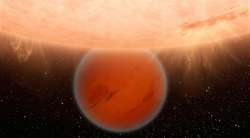Huge and powerful: New Jupiter-like planet can ‘spin’ its parent stars, claims research
New York: There is an evidence that a massive exoplanet a “hot Jupiter” is circling around its nearest satellite at such a high speed that it’s moving or ‘spinning up’ its nearby star with its

New York: The latest discovery of giant ‘hot Jupiter’ exoplanet, named ‘HATS-18b’ by the team of astronomers, is so powerful that it can influence the rotation of its star with its gravity. The giant exoplanet is orbiting its nearest satellite at such speed that it is actually ‘spinning’ up its nearby stars.
The roaster planet, which is 2,100 light years away, orbits its stars in a short time and can be easily observed in transit.
“The newly discovered exoplanet orbits its star in just 0.84 days, has a radius about 1.34 times that of Jupiter, and has twice the mass of the Jovian gas giant in our solar system”, the report said.
“The high planet mass, combined with its short orbital period, implies strong tidal coupling between the planetary orbit and the star,” said the researchers.
“The HATS-18 system is among the best systems (and often the best system) for testing a multitude of star–planet interactions, be they gravitational, magnetic or radiative, as well as planet formation and migration theories,” said a research team led by Kaloyan Penev of Princeton University
According to a research, published on the Cornell University Library which reads, “The high planet mass, combined with its short orbital period, implies strong tidal coupling between the planetary orbit and the star”
“In fact, we argue that [the star] HATS-18 shows signs of being tidally spun-up by the planet,” it reads.
Reasearcher are now trying to explore more about the relationship between the large gas planet and its star.
The study also states that, “Due to the proximity of the planet to its host star, this system provides one of the best laboratories for testing theories of star-planet interactions and planet formations.”
Earlier, Using data from Hubble and NASA's Spitzer telescopes, astronomers have revealed for the first time the diversity of atmosphere on exoplanets.
An international team of astronomers made the largest ever study of hot Jupiters, exploring and comparing 10 such planets in a bid to understand their atmospheres.
The team was able to discover why some of these worlds seem to have less water than expected -- a long-standing mystery.
To date, astronomers have discovered nearly 2000 planets orbiting other stars. Some of these planets are known as hot Jupiters -- hot, gaseous planets with characteristics similar to those of Jupiter.
They orbit very close to their stars, making their surface hot, and the planets tricky to study in detail without being overwhelmed by bright starlight.
Using the power of both telescopes allowed the team to study the planets, which are of various masses, sizes, and temperatures, across an unprecedented range of wavelengths.
"I am really excited to finally 'see' this wide group of planets together, as this is the first time we've had sufficient wavelength coverage to be able to compare multiple features from one planet to another," said David Sing from University of Exeter.
"We found the planetary atmospheres to be much more diverse than we expected,” he added.
The team's models revealed that while apparently cloud-free exoplanets showed strong signs of water, the atmospheres of those hot Jupiters with faint water signals also contained clouds and haze -- both of which are known to hide water from view.
"The alternative to this is that planets form in an environment deprived of water -- but this would require us to completely rethink our current theories of how planets are born," explained co-author Jonathan Fortney from University of California.
"Our results have ruled out the dry scenario, and strongly suggest that it's simply clouds hiding the water from prying eyes,” he added.
The results were published in the journal Nature.
(With inputs from Agency)
